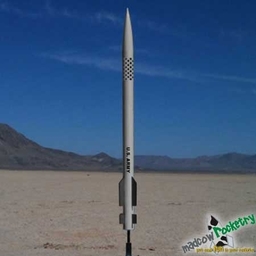   |
| Rating | |
| Length | 78.50" 199.39cm |
| Diameter | 4.00" 10.16cm |
| Weight | 3.75lbs 1.70kg |
| Parachute | 36" 91.44cm |
| Drogue | |
| Motor Mount | 38mm |
| Deployment | Single |
PAC-3-4"
File

 pac340.rkt.zip
pac340.rkt.zip 
 pac340.pdf
pac340.pdf Description
Features:
High Power Rocket
Heavy Duty Plastic Nose Cone
1/4" Plywood Laser Cut Fins and Rings
Delrin Rail Buttons
Dual Deploy Capable
Pre-slotted Airframe
9/16" Tubular Nylon Shock Cord
Cut Vinyl US ARMY Decal
Specifications:
Length: 78.5"
Diameter 4.0"
Weight: 60oz
Motor Mount: 38mm
Fins: 1/4" Plywood
Optional Recovery System:
36" Quality Nylon Chute
12x12 Chute Protector
Optional Altimeter Bay:
Choose a reduced price removable or standard altimeter bay upgrade. Note, the reduced price altimeter bay upgrade does not include a couple parts that are redundant with the parts included in the kit.
Optional Fiberglass Nose Cone:
Fiberglass nose cone is hand laid fiberglass with white gel-coat. Includes plywood bulkplate for eyebolt attachment point.
History:
The PAC-3 (Patriot Advanced Capability 3) missile is the ATBM (Anti Theater Ballistic Missile) component of the U.S. Army's Patriot air defense system, and will complement the existing MIM-104 Patriot missiles.
The PAC (Patriot Advanced Capability) program was begun in 1986 to develop a series of significant upgrades to the Patriot system. The ultimate step is PAC-3/Configuration 3, which introduces an upgraded AN/MPQ-65 radar to increase detection in high-clutter environments, and to improve discrimination of closely spaced objects (better decoy recognition). The most important feature of this new Patriot system, however, will be a completely new missile, a variant of the Lockheed Martin ERINT (Extended Range Interceptor) commonly called PAC-3. The PAC-3 missile is highly optimized for the anti-missile role (employing a hit-to-kill capability enhanced by a fragmentation warhead), so that operational PAC-3 Patriot units will be equipped eventually with both MIM-104 and PAC-3 missiles. The latter is significantly smaller than an MIM-104, so that 16 missiles instead of four can be carried in a single launch station. ERINT was first flight-tested in 1992, and selected as the ultimate PAC-3 missile in 1994. The PAC-3/ERINT integration tests took place from 1995 to 1997, and the missile is currently in full production at Lockheed Martin Missiles And Fire Control.


















